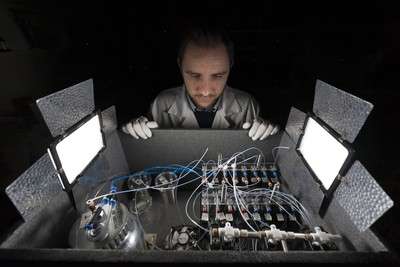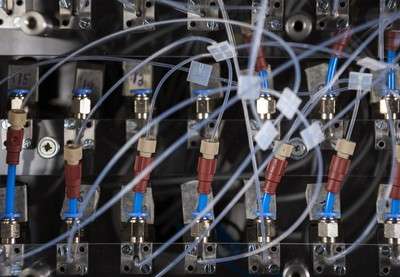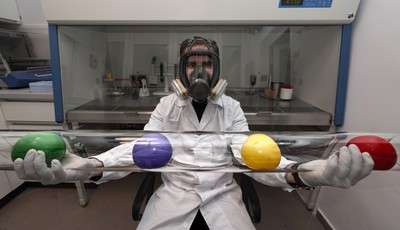A new type of monitoring provides information about the life of bacteria in microdroplets

In the future, it will be possible to carry out tests of new drugs on bacteria much more efficiently using microfluidic devices, in which each of the thousands of droplets moving through the microchannels can act as separate incubators. So far, however, there has been no quick or accurate method of assessing the oxygen conditions in individual microdroplets. This obstacle has now been overcome by researchers at the Institute of Physical Chemistry of the Polish Academy of Sciences.
The future of chemistry and biology labs consists of thousands of microdroplets whizzing through the thin tubules of microfluidic devices. The race is on to find technologies to carry out controlled chemical and biological experiments within microdroplets. At the Institute of Physical Chemistry of the Polish Academy of Sciences (IPC PAS) in Warsaw, a method for remote, rapid and accurate assessment of oxygen consumption by microorganisms in individual microdroplets has been demonstrated for the first time.
"Devices for the cultivation of bacteria in microdroplets could revolutionize work on the development of new antibiotics and the study of mechanisms responsible for drug resistance by bacteria. In one small microfluidic system, it is possible to accommodate several hundred or even several thousand microdroplets—and to carry out a different experiment in each of them—for example, with different types of microorganisms and at different concentrations of antibiotic in each drop," says Prof. Piotr Garstecki (IPC PAS). "For such studies to be possible, one has to provide the bacteria with conditions for development for a few weeks. Thus, knowledge about the flow of oxygen to the droplets and the rate of its consumption by the microorganisms becomes extremely important. In our latest system, we demonstrate how to read this key information."
The bioreactors of the future are water droplets with culture medium suspended in a carrier liquid with which they are immiscible (usually this is oil). In the channel of the microfluidic device, each droplet is longer than it is wide, and it almost completely fills its lumen; sizes matched in this manner ensure that the drops do not swap places in the channel and throughout the duration of the experiment, they can be identified without any problems. At the same time, there has to be a thin layer of oil maintained continuously between each microdroplet and the wall of the channel. Otherwise, the bacteria would be in direct contact with the walls of the channel, and would be able to settle there and move from drop to drop. Currently, when the microdroplet is stationary, it eventually pushes out the oil separating it from the walls, laying it open to contamination. For this reason, the drops must be kept in constant motion—even for weeks.

Growing bacteria need a culture medium, and waste products need to be removed from their environment at an appropriate rate. Information about the bacterial oxygen consumption in individual droplets is therefore crucial to the operation of microbioreactors.
"It is immediately obvious where the problem lies. In each of the hundreds of moving droplets, measurements need to be carried out at a frequency corresponding to the frequency of division of the bacteria or higher, in practice, at least once every 15 minutes. In addition, the measurement cannot cause any interference in the microdroplets," says Ph.D. student Michal Horka (IPC PAS), a co-author of the publication in the journal Analytical Chemistry.
Collaborating chemists from the Austrian Institute of Analytical Chemistry and Food Chemistry at the Graz University of Technology provided polymer nanoparticles with a phosphorescent dye, which, after excitation, emit light for periods corresponding to the concentration of oxygen in the surrounding solution. The nanoparticles underwent tests at the IPC PAS on bacteria in order to determine their possible toxicity—none was found.
Research on monitoring oxygen consumption in the droplets commenced with the preparation of an aqueous solution containing the bacteria, the culture medium and a suitable quantity of nanoparticles. The mixture was injected into the microfluidic system constructed of tubing with Teflon connectors with correspondingly shaped channels. The first module formed droplets with a volume of approximately 4 microlitres, which were directed to the incubation tube wound on a spool. In the middle of its length, there was another module, with detectors for measuring oxygen and absorbance.

"In the incubation part in one phase of the cycle, the droplets flowed in one direction; in the second part of the cycle, in another direction, electronically controlled by means of suitable solenoid valves. All this looks seemingly simple enough, but in practice, one of the biggest challenges was to ensure a smooth transition between the detection module and the tubing, so that bacterial contamination did not occur at the connections," explains Ph.D. student Horka.
During their passage through the detection module, the droplets flowed under an optical sensor, which measured the so-called optical density, the standard parameter used to evaluate the number of cells—the more bacteria in the droplets, the less light passes through them. In turn, the measurement of the duration of the phosphorescence of the nanoparticles, evaluating the concentration of oxygen in the microdroplets, was carried out using the Piccolo2 optical detector, provided by the Austrian group. This detector, which looks like a big pen drive, was connected directly to the USB port on the control computer. Comparing information from both sensors, IPC PAS researchers showed that the microfluidic device they had constructed made it possible to regularly and quickly monitor the metabolic activity of bacteria in the individual microdroplets.
"We carried out our tests both with bacteria floating in water singly as well as with those having a tendency to stick together in clumps, as is the case for tuberculosis bacilli or others belonging to the same family including Mycobacterium smegmatis that we studied. Evaluation of the rate of oxygen consumption by both species of microorganisms proved to be not only possible, but also reliable," says Ph.D. student Artur Ruszczak (IPC PAS).
The results of the research, funded by the European ERC Starting Grant (Polish side) and the Maria Sklodowska-Curie grant are an important step in the process of building fully functional microfluidic devices for conducting biological experiments lasting many weeks. A system for culturing bacteria in microdroplets was developed at the IPC PAS a few years ago, but it was constructed on a polycarbonate plate. The maximum dimensions of the plate did not exceed 10 cm, which greatly limited the number of droplets; in addition, as a result of interaction with the polycarbonate, after four days, the channels were contaminated with bacteria. Devices of Teflon modules and tubing would not have these disadvantages, and would be suitable for practical applications.
More information: Michał Horka et al, Lifetime of Phosphorescence from Nanoparticles Yields Accurate Measurement of Concentration of Oxygen in Microdroplets, Allowing One To Monitor the Metabolism of Bacteria, Analytical Chemistry (2016). DOI: 10.1021/acs.analchem.6b03758
Journal information: Analytical Chemistry
Provided by Polish Academy of Sciences



















